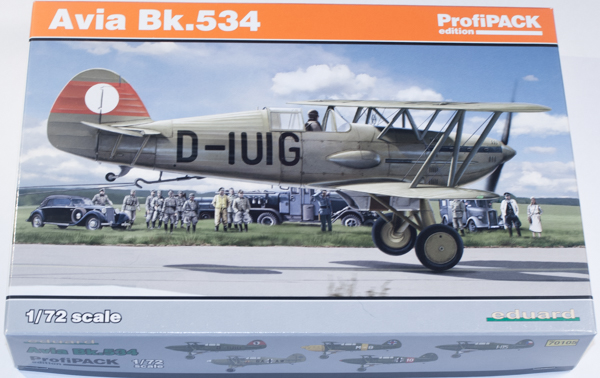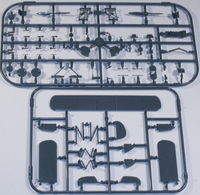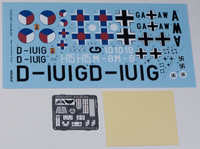
Eduard 1/72 Avia Bk.534 ProfiPACK
By Matt Bittner
Introduction
Eduard's instructions provide the best, concise history of the Avia B.534:
"The Avia B.534 was developed in 1934 as an extension of the B.34 fighter. In this incarnation, which was produced in small numbers for the Czechoslovak Air Force (the majority of which were attached to No.3 Fighter Regiment in Slovakia at the beginning of the Second World War), there were several engine/airframe combinations tried. The B.234 prototype served as the basis for the re-engined (Hispano Suiza 12 Ydrs for the original Avia R-29 radial) type that became the true B.534. This was the 1934 victor in a tender for a new standard fighter for the air force, and in June of that year, Avia received an order for an initial 34 aircraft. The orders accumulated to a total of 568 units, built in several production blocks.
"Assessments of the aircraft are somewhat variable. At the time of its development, it was an aircraft that was technically sound and utilized progressive construction techniques, but by the time of the Munich Crisis, the technology was slowly but surely entering the realm of the obsolete. To top it off, the politics of the situation during the Crisis disallowed the chance of combat. The chance for combat missions to be flown didn't occur until a few years later, in 1941, in the services of the Slovak State, fighting for the side that had previously been the aggressor against which they were to stand. Slovak pilots flying the B.534 on the Eastern Front gained good results, and these can be viewed upon as being the climax of the career of the type. A year later, it was apparent that replacement by more modern types was necessary, and inevitable. Bulgarian attempts to combat Ploesti raiding B-24 Liberators with the B.534 was a failure, and the aging planes were not able to climb to the Liberator's operational altitudes. In Slovakia, as in Bulgaria, the type was destined for second line relegation.
"Some of the remaining B.534s were destined for final operations within the Bulgarian Air Force in operations over Hungary in 1944, and with Slovakia during the several weeks long uprising against Germany (late August early November 1944). During the Slovak National Uprising, the type was used primarily in the ground attack role, and one did manage a kill to become what is the last aerial victory of a biplane in history. It should be noted that the kill in question was that of a Hungarian transport. The fact remains that the Slovak National Uprising did end up being the swansong of the Avia B.534. Certainly, it can be said that due to the era and climate of the service of this aircraft, and the length of service it was able to achieve, the Avia B.534 has become one of the most profound symbols of Czechoslovak aviation history, a very positive symbol.
"During the installation of the Hispano Suiza 12 Ydrs engine that was used in all Avia B.534s, the use of a Hispano 20mm cannon along with the machine guns was considered. This would have necessitated the installation of the Hispano Suiza 12Ycrs. This powerplant was installed into the second B.534 prototype as early as 1936 and was intensively tested. The Ministry of National Defence was adamant that Oerlikon FFS-20 cannon be used and this required a list of changes that protracted the development of the type. All of the changes were finally tested on Bk.534.501, the first of the type that first flew on April 29th, 1938. Before that, in 1937, 54 aircraft were ordered (Bk.534.501 to Bk.534.554), plus a further sixty prior to the Munich Crisis. Production of the type began in the summer of 1938 but at the time, all of the details for the installation of the cannon had not yet been worked out and so a third machine gun was mounted instead. The 'cannon' armed Bk.534 differed from the B.534 IV Serie in that they lacked the air intake under the nose and they gained small intakes on the sides of the engine. Because there was only one machine gun in each side of the fuselage, they were covered with smaller fairings.
"Prior March 15th, 1939, when the remnants of the Republic were occupied by German forces, the Czechoslovak Air Force had only taken delivery of three series produced Bk.534s. The remainder of the production run was taken over by the German occupation administration."
The Kit
The Eduard 1/72 Avia Bk.534 (#70105) consists of 60, gray injected parts (some not used for this version), a clear injected sprue with three parts (again, there are more parts that aren't used for this version), one photoetch fret and a set of masks. There are decals for five aircraft, most finished in green/khaki tops and aluminum bottoms:
- c/n 592, Erprobungestelle Travemu(umlaut)nde, Travemünde, Germany, 1940/1941
- c/n 524, Jagdfliegerschule 3 or 4, Germany, early 1940s
- Flugzeugführerschule A/B 115, Weis, German, June 1942 (finished overall in RLM 02)
- Air Regiment 4, Praha – Kebly, Czecho-Slovak Republic, March 1939
- c/n 519, No. 13 Squadron, Spisska Nova Ves, Slovak Republic, 1941 (this one also has a yellow nose, yellow wing tips on the upper wings' underside and a yellow stripe around the fuselage)
Decals, by Eduard, look excellent and in register, and include stencils.

|
I'll refer the reader to two other articles. The first is my full build of the Eduard III. serie; the second is the First Look I recently wrote on the I./II. serie Dual Combo. The last one so you can get a gist of what Eduard's B.534s look in the box. The biggest difference between that earlier version boxing and this is, besides the different fuselage and wings to make the Bk.534, but also an extra part if you're building the c/n 592 machine. It was one of the two that was tested with a tail hook for landing on the Graf Zeppelin. In addition, this kit was designed to display the canopy open only.

|
One thing that is really nice, especially if you have a number of Eduard B.534s, is the extra parts you'll have after finishing any of the B.534s, this one is no exception. There are two common sprue between all types which contains all the smaller parts along with the clear sprue. Having extra parts helped me with my III. serie build because I lost the windscreen. This was not a problem because I took the III. windscreen from the IV. serie kit I started at the same time.

|
Conclusion
The Eduard B.534s are the best of the type in 1/72 and now that Eduard released the Bk.534 Eduard has covered all versions of this important Czech biplane. You can rest assured that building an Eduard B.534 is without peer.
I definitely thank Eduard for sending the Bk.534 for review.
